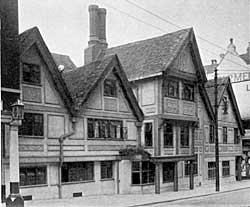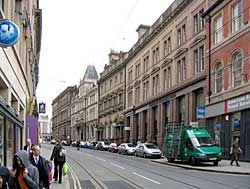< Previous | Contents | Next >
An itinerary of Nottingham
The Poultry and Victoria Street
THE POULTRY.

The Flying Horse Hotel in the 1930s. It was converted to an up-market shopping arcade in the 1990s.
The Poultry was called the Women's Market in 1396 and the Hen Cross in 1416, and got its present name about 1800, but from 1332 to 1799 it is frequently referred to as Cuckstool Row, because presumably, the cucking stool or ducking stool was kept there. This implement of torture was removed and more or less abandoned in 1731 consequent upon the death of a woman who had been ducked as a scold.
The interesting house in this row is the "Flying Horse" Hotel which bears on its signboard the year 1483. Its architecture, however, seems to point to a little later date than then and I should assign it to Elizabeth's reign, probably contemporary with the Spanish Armada. Mysteriously enough this interesting house can supply very little gossip, all that is known about it is that in the 18th century it was called the "Travellers Inn." But all it lacks in gossip it makes up in architectural interest for it is a most excellent example of the filching of public land from the streets which took place all through the Middle Ages. The timbers carrying overhanging upper stories were apt to become weak and were strengthened by posts extending from their outer ends to the ground and these posts curiously enough have been suffered to remain for centuries and are now represented by pillars which intrude very much upon what centuries ago must have been the public roadway. Its modern name of "The Flying Horse" is interesting. The Flying Horse is Pegasus, the steed ot the Muses, upon whose back Bellerophon mounted when he went to destroy the Chimera. But it has a more interesting origin than this reference to classic myth for the Flying Horse was the badge of the Knights Templars who were suppressed in 1309. This order of military monks undertook to protect the Temple at Jerusalem from the assaults of the infidel and in order better to perform their work they vowed themselves to poverty and to emphasize how poor they were they took for their badge a picture of two men mounted upon one horse, showing that they were too poverty stricken to adequately horse their knights. This badge was copied and re-copied and although it always remained evident what the horse was meant to represent the two human figures upon its back seemed to have mystified the copyists and they became less and less like men and more and more like wings so that when the Renaissance came along and men's minds were filled with all sorts of classic stories they recognised in this weird, winged horse Pegasus the Flying Horse of the Muses.
VICTORIA STREET.

Victoria Street from the corner with High Street (A Nicholson, 2004).
Victoria Street is quite modern and the whole of this part of the town has been so re-modelled that its ancient lay-out has been completely lost. Originally a narrow lane called Chandler or Chandlers Lane ran more or less parallel with Bottle Lane. Bottle Lane and Chandlers Lane joined and after a few yards debouched upon Bridlesmith Gate about where the County Club now stands. But in 1863 this ancient road was cleared away and widened into the modern Victoria Street, which is only noticeable because underneath it runs the first subway for conducting sewers, gas pipes and so forth that was ever constructed out of London. It was illuminated in 1875 in celebration of a visit of an engineering society, for it was a great step in public work and our forefathers were justly very proud of it and desired to show it to their contemporaries.
The old Post Office at the corner of Old Queen Street and Victoria Street was built in 1868 from the designs of a certain Mr. Williams, a London architect, and the only other object which reminds us of the past is the Journal Buildings on the northern side which are now occupied for purposes other than that of newspaper production.
The first newspaper to be published in Nottingham appears to have been The Weekly Courant, which was issued by William Ayscough in August, 1712, and its price was three halfpence. It was succeeded by The Nottingham Post, commenced in 1716. In 1723 The Nottingham Post came into Mr. Ayscough's hands, and we find him publishing in that year The Nottingham Weekly Courant. Its price was twopence, which was raised eventually to twopence-halfpenny. This Courant lasted until 1769, when it was bought by a Mr. Cresswell, who changed its name once more into The Nottingham Journal. There was a rival publication The Nottingham Mercury, in existence some time about 1723,and in 1772 George Burbage started The Nottingham Chronicle, but this was not a success and only lasted for three years. The Nottingham Journal passed through various hands and eventually in 1841 became the property of Mr. Bradshaw. In 1780 Henry Cox commenced The Nottingham Gazette, but this only lasted a few weeks, and in 1808 Charles Sutton established The Nottingham Review. There were various papers which had an ephemeral existence such as The Nottingham Herald, but none of them were of great importance until The Nottinghamshire Guardian was established in 1846. It was first published by B. S. Oliver of Long Row, and eventually came into the hands of the Forman family, with whom it still remains.
